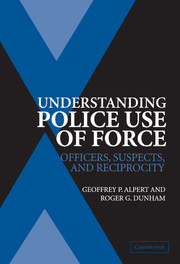Book contents
- Frontmatter
- Contents
- Acknowledgments
- Introduction: The Context of Police Use of Force
- 1 Police Use of Force: The History of Research
- 2 The Crucial Element: Finding Research Sites
- 3 Findings from Miami-Dade Police Department Study
- 4 The Sequential Steps in Use-of-Force Incidents in the Miami-Dade Police Department
- 5 Miami-Dade Police Department: Inconsistencies between Officer and Suspect Accounts of the Use of Force
- 6 Findings from Prince George's County Police Department
- 7 Findings and Summary
- 8 Explaining Police Use of Force: The Breakdown of an Authority Maintenance Ritual
- Appendix: Frequencies of Force Sequences for First through Tenth Actions
- Index
- References
4 - The Sequential Steps in Use-of-Force Incidents in the Miami-Dade Police Department
Published online by Cambridge University Press: 14 July 2009
- Frontmatter
- Contents
- Acknowledgments
- Introduction: The Context of Police Use of Force
- 1 Police Use of Force: The History of Research
- 2 The Crucial Element: Finding Research Sites
- 3 Findings from Miami-Dade Police Department Study
- 4 The Sequential Steps in Use-of-Force Incidents in the Miami-Dade Police Department
- 5 Miami-Dade Police Department: Inconsistencies between Officer and Suspect Accounts of the Use of Force
- 6 Findings from Prince George's County Police Department
- 7 Findings and Summary
- 8 Explaining Police Use of Force: The Breakdown of an Authority Maintenance Ritual
- Appendix: Frequencies of Force Sequences for First through Tenth Actions
- Index
- References
Summary
in this chapter, we review the sequence of actions between officers and suspects from the moment the officer arrives on the scene. This interaction process is key to understanding how situations develop between officers and citizens and how force is used with regard to the interdependent actions (and reactions) of the officers and citizens. What the officer sees the suspect doing, how the officer responds, how the suspect responds to the officer's first action, and how the officer then responds to the suspect, all affect the sequence of events and the levels of suspect resistance and officer use of force. The result may be as benign as an officer peacefully questioning a suspect or as menacing as a deadly shoot-out. This chapter, then, is a first attempt to analyze these interactions in this way. Before we present our analysis, we give a brief discussion of several other attempts to look at the sequence of police–citizen interactions.
Richard Sykes and Edward Brent (1983) analyzed routine police–citizen contacts by looking at encounters and utterances. Their research focused on the three decisions an officer must make in every encounter: defining the situation, ascertaining who is involved, and determining how the encounter should be handled. They observed 1,622 encounters in 1973, and recorded the sequence and temporal order of statements made by officers and civilians that referred to defining, controlling, resisting, and confirming the situation.
- Type
- Chapter
- Information
- Understanding Police Use of ForceOfficers, Suspects, and Reciprocity, pp. 87 - 123Publisher: Cambridge University PressPrint publication year: 2004



